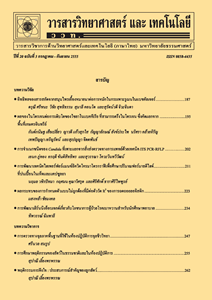การผลิตลูกชิ้นปลาเสริมผงกระดูกจากปลาแซลมอน ลูกชิ้นปลาเสริมผงกระดูกปลา
Main Article Content
บทคัดย่อ
อุตสาหกรรมการผลิตอาหารทะเลแปรรูปก่อให้เกิดเศษเหลือทิ้งเป็นจำนวนมาก โดยเฉพาะกระดูกปลา ซึ่งกระดูกปลาแซลมอนเป็นหนึ่งในเศษเหลือทิ้งดังกล่าว งานวิจัยนี้จึงมีวัตถุประสงค์ในการศึกษาการผลิตผงกระดูกจากปลาแซลมอน เพื่อใช้ในการปรับปรุงลักษณะเนื้อสัมผัสของผลิตภัณฑ์ลูกชิ้นปลา โดยศึกษาวิธีการเตรียมกระดูกปลาแซลมอน 2 สายพันธุ์ ได้แก่ Pink salmon (Oncorhynchus gorbuscha) และ Atlantic salmon (Salmo salar) ใช้หม้อให้ความร้อนภายใต้ความดัน แปรอุณหภูมิที่ใช้ในการนึ่งภายใต้ความดัน 3 ระดับ ได้แก่ 120, 130 และ 140 ºC และเวลา 3 ระดับ ได้แก่ 30, 60 และ 90 นาที พบว่าอุณหภูมิและเวลาในการนึ่งไม่มีผลต่อค่าความแน่นเนื้อของกระดูกปลา Pink salmon อย่างมีนัยสำคัญ (p > 0.05) แต่ส่งผลต่อกระดูกปลา Atlantic salmon โดยการนึ่งกระดูกปลาที่อุณหภูมิ 140 ºC 60 นาที ส่งผลให้กระดูกปลามีค่าความแน่นเนื้อต่ำและมีปริมาณโปรตีนอยู่ในระดับปานกลาง จึงเลือกสภาวะนี้ไปศึกษาสภาวะการอบแห้งที่เหมาะสม โดยแปรอุณหภูมิที่ใช้ในการอบแห้ง 3 ระดับ ได้แก่ 50, 60 และ 70 ºC และเวลา 3 ระดับ ได้แก่ 90, 120 และ 150 นาที พบว่าการอบแห้งที่อุณหภูมิ 70 ºC ส่งผลให้มีปริมาณผลผลิตและค่าความขาวสูงที่สุด ส่วนการอบแห้งที่เวลา 120 และ 150 นาที ส่งผลให้มีค่าปริมาณน้ำอิสระน้อยที่สุดและไม่แตกต่างกัน (p > 0.05) จึงเลือกการอบแห้งที่อุณหภูมิ 70 ºC 120 นาที นำไปศึกษาปริมาณผงกระดูกปลาแซลมอนที่เหมาะสมในการผลิตผลิตภัณฑ์ลูกชิ้นจากซูริมิปลาทรายแดง แปรปริมาณผงกระดูกปลา 4 ระดับ ได้แก่ ร้อยละ 0, 1, 3 และ 5 โดยน้ำหนักซูริมิ พบว่าการเติมผงกระดูกปลาร้อยละ 3 ส่งผลให้ลูกชิ้นปลามีค่าความแข็งแรงของเจลมากขึ้นและค่าการสูญเสียน้ำหนักลดลง ค่า hardness และ chewiness เพิ่มขึ้น ส่วนค่า cohesiveness ลดลง เมื่อเปรียบเทียบกับตัวอย่างที่ไม่มีการเติมผงกระดูกปลา โดยได้รับคะแนนจากการทดสอบทางประสาทสัมผัสด้านรสชาติและความชอบโดยรวมสูงที่สุด
Article Details
เอกสารอ้างอิง
Office of Industrial Economics, 2019, Statistic in Industries, Available Source: https://indexes.oie.go.th/industrialStatistics1.aspx, October 22, 2020. (in Thai)
Ramirez, A., 2007, Salmon By-product Protein, Food and Agriculture Organization of United Nation, Rome.
Benjakul, S. and Karnjanapratum, S., 2018, Characteristics and nutritional value of whole wheat cracker fortified with tuna bone bio-calcium powder, Food Chem. 259: 181-187.
Yin, T. and Park, J.W., 2014, Effects of nano-scaled fish bone on the gelation properties of Alaska Pollock surimi, Food Chem. 50: 463-468.
Yin, T., Reed, Z.H. and Park, J.W., 2014, Gelling properties of surimi as affected by the particles size of fish bone, LWT Food Sci. Technol. 58: 412-416.
Niludomsak, S., 2001, Effect of Ingredients on Texture of Fishball, Master Thesis, King Mongkuts University of Technology Thonburi, Bangkok. (in Thai)
AOAC, 1995, Official Methods of Analysis, 16th Ed., The Association of Official Analytical Chemists, Washington, DC.
Phisutthigoson, S., Jirapeatsayasuk, P., and Sompongse, W., 2018, Production of fish ball with konjac glucomannan gel and herbs, J. Sci. Technol. 26(2): 224-235. (in Thai)
Jarunatvilat, A., 2000, Utilization of Skipjack Tuna Katsuwonus pelamis Bone as Calcium Source in Snacks, Faculty of Science, Chulalongkorn University. (in Thai)
Suwannaporn, P., 2018, Physical Modifica tion of Starch and Its Applications in Foods, Pornsap Publishing, Bangkok. (in Thai)


